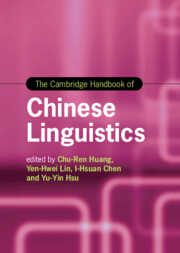Book contents
- The Cambridge Handbook of Chinese Linguistics
- Cambridge Handbooks In Language and Linguistics
- The Cambridge Handbook of Chinese Linguistics
- Copyright page
- Contents
- Figures
- Tables
- Contributors
- Acknowledgments
- Part One Writing System/Neuro-cognitive Processing of Chinese
- Part Two Morpho-lexical Issues in Chinese
- Part Three Phonetic-phonological Issues in Chinese
- 11 The Morphophonology of Chinese Affixation
- 12 Mandarin Chinese Syllable Structure and Phonological Similarity
- 13 Tonal Processes Defined as Articulatory-based Contextual Tonal Variation
- 14 Tonal Processes Defined as Tone Sandhi
- 15 Tonal Processes Conditioned by Morphosyntax
- 16 Tone and Intonation
- 17 Evidence for Stress and Metrical Structure in Chinese
- 18 Perceptual Normalization of Lexical Tones
- Part Four Syntax-semantics, Pragmatics, and Discourse Issues
- Index
- References
13 - Tonal Processes Defined as Articulatory-based Contextual Tonal Variation
from Part Three - Phonetic-phonological Issues in Chinese
Published online by Cambridge University Press: 04 August 2022
- The Cambridge Handbook of Chinese Linguistics
- Cambridge Handbooks In Language and Linguistics
- The Cambridge Handbook of Chinese Linguistics
- Copyright page
- Contents
- Figures
- Tables
- Contributors
- Acknowledgments
- Part One Writing System/Neuro-cognitive Processing of Chinese
- Part Two Morpho-lexical Issues in Chinese
- Part Three Phonetic-phonological Issues in Chinese
- 11 The Morphophonology of Chinese Affixation
- 12 Mandarin Chinese Syllable Structure and Phonological Similarity
- 13 Tonal Processes Defined as Articulatory-based Contextual Tonal Variation
- 14 Tonal Processes Defined as Tone Sandhi
- 15 Tonal Processes Conditioned by Morphosyntax
- 16 Tone and Intonation
- 17 Evidence for Stress and Metrical Structure in Chinese
- 18 Perceptual Normalization of Lexical Tones
- Part Four Syntax-semantics, Pragmatics, and Discourse Issues
- Index
- References
Summary
This chapter reviews studies on contextual tonal variation in Chinese languages, often referred to as ‘tonal coarticulation’ in the literature. We start by explaining why the term ‘contextual variation’ is preferred to ‘coarticulation’ for tones, before introducing different types of contextual variation observed in Chinese languages. The following processes are covered: assimilatory vs. dissimilatory carryover effects, anticipatory effects, microprosodic effects, and pre-planning effects. Next, three debated issues in Chinese linguistics related to contextual variation are discussed. First, are dynamic tones (e.g., rise, fall) underlyingly dynamic or made up of sequences of static tones (e.g., Low-High)? Second, are tones hosted in the rhyme or across an entire syllable? Third, does the Mandarin neutral tone have an underlying target or is it unspecified? Different views on these issues are presented with suggestions on how some of them may be tested and falsified.
- Type
- Chapter
- Information
- The Cambridge Handbook of Chinese Linguistics , pp. 275 - 290Publisher: Cambridge University PressPrint publication year: 2022
References
- 1
- Cited by

